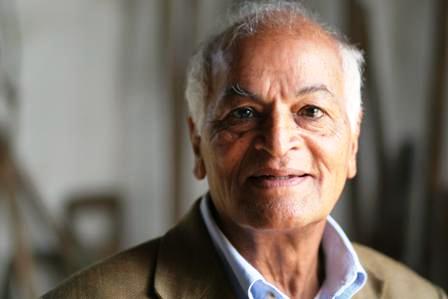
HereNow4U readers online
(click on picture to see actual situation)
History and culture on a worldwide scale have developed to the point where some of the teachings and practices of Jainism have become imperative if life, and especially human life, is to continue (James E. Royster Cleveland State University, U.S.A.).
feeling which even the westerners have started expressing increasingly about the sacred Jainism, particularly for its doctrines of ahimsa (non-injury and non-aggression), co-existence, Anekanta and Syadvada and the scientifically based code of conduct.
Jainism is a primitive, one of the most ancient religions which came into existence as a result of the most non-violent approach and humanitarian view point towards all creatures. It is an indigenous religion originated and developed in India with a profound progressive attitude and judicious understanding of special requirements and philosophical indispensable necessities of the time. It believes that all the particles of earth, water, fire, wind and plants are possessed of life. The universe is eternal and indestructible and was not created by God.
It has exerted an influence in India that far exceeds its relative size. But it has not been read and understood on a wider scale in the western world. Mrs. N. R. Guseva, a U.S.S.R. writer, in the introduction to her book "Jainism" writes that study in Jainism is very slender. During last 100-150 years thousands of works have been written about other religions in India, particularly Hinduism and Buddhism, but nor more than several hundreds are devoted to Jainism, that too mostly written in Indian languages. She further writes that the illustrious Russian scholar and indologist I. P. Minayev devoting one of his works to Jainism observed that the religion was not studied intensively and that there was no material on it in European libraries and collections. Professor Kay Koppedrayer of the University of Wilfred Laurier at Waterloo says "With the exception of those with Indian background of those who have taken a secondary school level world religions course most university students I teach know nothing whatsoever of Jainism".
Jainism though an ancient religion is neither known nor taught at schools, colleges and universities of the world in the format that a world religion is introduced to pupils.
CLASSIFICATION OF JAINA KNOWLEDGE
Jainism classifies knowledge in two ways:
- Canonical (Agamika)
- Philosophical (Darsanika).
Canonical Literature
The canonical literature (believed to be directly delivered from the Tirthankaras is divided into two viz. (1) Sutragamas and Arthagamas. Sermons of the Tirthankaras are called Arthagamas and the Sutras written over those are named Sutragamas.
Canonical literature consists of some sixty texts divided into three groups of works known as Purva (14 texts), Anga (12 texts) and Angabahya (34 texts) all handed down in an ancient Magadhan language called Ardhamagadhi.
The Digambaras and Swetambars are unanimous in affirming that Acharya Bhadrabahu I (expired in 365 B.C.) was the last Srutkevali, who knew all the 14 Purvas by heart. After him knowledge of the Purvas was lost, most of those medicants who had memorised portions thereof perished in the great Magdha famine.
The Digambaras maintain that the Anga and Angabhaya texts were "totally lost" as early as the 2nd century A.D. The "Satkhandagama" (Scripture in six parts) and "Kasayaprabhrata" are the only canonical works that the Digambaras posses.
The Swetambars, however, maintain that the loss of Anga and Angabahya texts was not total (It is likely that the Digambar sect actually did lose whatever canonical material they may have possessed during their migration to the south during famine and subsequent isolation from the bulk of the Jaina medicant community). The Swetambars, who had inherited the scriptures that had been approved at the Patliputra Council, held in 367 B.C. (Vir Nirvana 160) organised by Acharya Sthulabhadra, were able to preserve large portion of Anga and Angabahya material even though they had lost the Purvas and the Dristivada Anga.
The earliest date of which the Jaina Acharyas began to put the canon into written form is not known; this must have taken place prior to the second council which was held at Mathura under the guidance of Acharya Skandila (A.D. 300-343) after Vir Nirvana 827-840 (4th century A.D.). The Swetambar tradition that speaks of this council also alludes to another synod held concurrently at Valabhi (Saurashtra) under the supervision of Acharya Nagarjuna. It is said that the two leaders could not meet in order to resolve the differences in their recensions at that time; such a resolution was accomplished, however, by a third and last council, again at Valabhi, which took place either 980 or 993 years after Mahavira Nirvana (that is either in A.D. 453 or 466). The leader of this meeting Devardhigani Ksamasramana, compiled the final redaction of the extant canon and had it committed to writing in its entirely.
Substantial Jaina literature is available written in Prakrit, Apabhramsa, Sanskrit, Kannarese, and Hindi languages on various subjects like religion, philosophy, Jain saints traditions, history, culture, literature, astronomy, cosmology, geography, mathematics, ayurveda etc. But very little has been written in English so as to be read in the rest of the world.
JAINISM IN THE WEST THROUGH LITERATURE
The orientalists and the missionaries in India did work on Jaina studies in 1970s - 1820s. Dr. George Buhler (1837 - 1899), a German, who taught a Elphinstone College, Bombay from 1863 to 1878, collected large number of Jaina manuscripts; established the antiquity of Jaina ascetic lines of spiritual and teaching decent from inscriptional studies and wrote books on various subjects. Dr. Hermann Jacobi, another German scholar, (1850-1937) produced two volumes on Jaina texts.
In Boston with its Harvard indological scholars, the first Indian work reaching U.S.A. is a book printed and published by the American mission Press in Bombay in the 1940s.
Translation of Kalpasutra and Nava - Tatva was done in 1847 by Rev. J. Stevenson. A valuable work on Jainism "Life And Stories of Jaina Saviour Parsvanatha" was published by Prof. Maurice Bloomfield, who was born in Austria and at the age of four moved to U.S.A.. Having his Ph.D. in 1897, he had further studied in Berlin and Leipzig in Germany. He came back to U.S.A. in 1881 as Professor of Sanskrit at John Hopkins Institute. Late in his career, he began work in Jain Maharashtri and Jainology.
Shri Vir Chand Gandhi, an English knowing Gujrati Jain, who participated in India in the Parliament of World Religions at Chicago in 1892 and was introduced there as one of the Chief Exponents of Jain religion, introduced Jainism in U.S.A. in its most brevity. His English disciple Herbert Warren wrote about Vir Chand Gandhi's Achievements in his work. William Norman Brown (1892-1975) from Baltimore (U.S.A..) studied at John Hopkins Institute and at Varanasi and taught at Jammu. His works included Jain miniatures and manuscript illustrations. The lectures of Heinrich Zimmer (Germany) on Jaina teachings were after his death edited by Joseph Campbell and published. Kendall W. Folkert was a promising Jainologist from Harvard University whose work was recognized. R. William's "Jain Yoga" portrays Jain ideas of physiology, psychology and holistic approach to health.
As foreign scholars began studying Jainism, the Jain authors also produced their works with editions and critical texts, barrister Champat Rai Jain's (1867 - 1942) works - Key of knowledge, Confluence of Opposites, Jain logic, Psychology, What is Jainism, Jain Law, Jain Penance, Jain Culture are important creations. Barrister Jugmandir Lal Jaini (1881-1927), who went to Oxford (1906-1910) devoted much of his time to the study of Jain scriptures and literature. He translated Tatvarthasutra, Atmanushasana, Pancastikayasara, Samayasara, Jiva-Karma-kanda, and initiated the translation of Gommatsara. His "The Outlines of Jainism" was published by Cambridge University Press in 1986. He had established Jain Library in London, and Central Jain publishing House in India.
Dr. Hiralal Jain (1898 - 1973) who followed J.L. Jaini, completed the translation of Gommatasara (1923), edited 16 volumes of Satkhandagama Siddanta (1935-1959) and Prakrit works. Dr. A. N. Upadhye (1906-975), a keen researcher, head to his credit nearly 25 critical editions of Sanskrit and Prakrit works, 150 research articles, and he worked together with Dr. Hiralal Lal Jain and lectured in some foreign universities and conferences on Jaina subjects.
Y. J. Padmarajiah's "A comparative Study of The Jaina Theories of Reality and Knowledge" published in 1963, is his work (1947 - 1952) for which the degree of Doctor of philosophy was awarded to him by Oxford University.
Prof. Padmanabh S. Jaini's (University of California, at Berkeley, U.S.A.) "The Jaina Path of Purification" has been highly hailed as one of the best studies in the religions of South Asia in this century and certainly the best on Jainism. In his other works "Gender and Salvation" "Jaina Debates on the Spiritual Liberation of Women" he has presented tightly and meticulously argued analysis of ancient Jain discussions about whether only the totally unclothed can reach the goal (attain salvation- Nirvana).
In brief, starting from the mid of the 19 century various western scholars notably Dr. Hermann Jacobi, R. J. Stevenson, Herbert Warren, B.A. Salotore, H. v. Glasenapp; Moriz Winternitz, Heinrich Zimmer, Walter Schubring, R. William, Mrs. Sinclair Stevenson, F.M. Thoms, Paul Marett, Stephen Rosen, Ken Oldfield, Colebrook, Buchanan, Dr. Georg Buehler, Joseph Campbell, Esther Solomon, Maurice Bloomfield, Kendall W. Folkert, Dr. Michael Tobias, Mrs. N. R. Guseva, Ms. Collette Cailiat wrote treaties on canonical subject; Jain literature, outlines of Jainism etc.
Hinduism Buddhism, Christianity and Islam are the four principal religions of the world. With national and international support these flourished well in and outside the countries of their origin. This has not been the case with Jainism. Though initially Jainism developed from the ruling class itself and also in the ancient period of the Indian history it was patronised by some great emperors and rules but by the thirteenth century and onwards it lost their support. General belief about the obscure nature of Jainism laying great stress on austerities, non possessiveness, renunciation, self control, a highly regulated code of conduct, and increasing popularity of Shaivism much came in the way of popularisation and spread of Jainism and it remained confined to a very small proportion of the entire Indian population and to some extent to Indian settlers in foreign countries.
 Satish Kumar
Satish Kumar